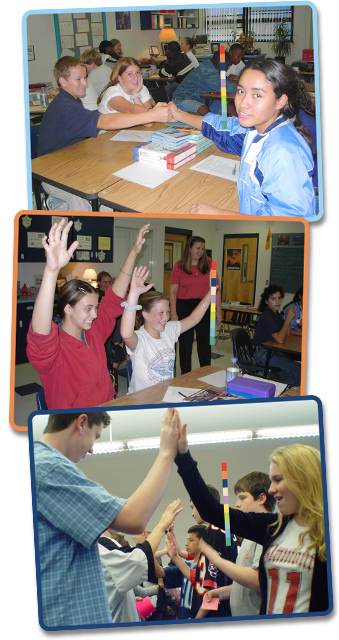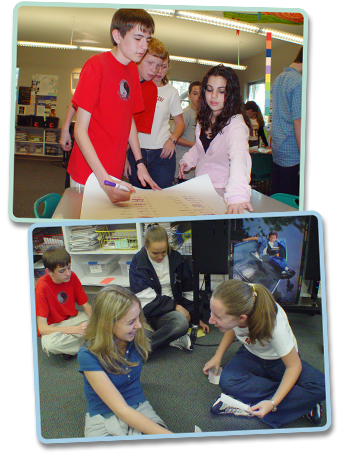Kagan's Articles - FREE Kagan Articles
Research & Rationale
Secondary School Education and Cooperative Learning: A Perfect Match
Special Article
Secondary School Education and Cooperative Learning: A Perfect Match
Daren Harris
To cite this article: Harris, D. Secondary School Education and Cooperative Learning: A Perfect Match San Clemente, CA: Kagan Publishing. Kagan Online Magazine, Issue #55. www.KaganOnline.com

“I just don’t learn as much by myself. I liked school better when we worked in teams and I got to hear from other kids. I learned more when I got to hear them, and it helped me with my thinking. I just don’t like school now, Dad.” This is part of a recent conversation I had with my 15 year old daughter who is about to finish her freshman year in high school. Like most parents, I always ask her about her day and how school is going for her. For the first time, “I don’t like school” has become a part of the answer each time. As a parent first and an educator second this statement is very concerning to me, but I was not surprised. When I reflect upon the conversations with my daughter it is clear to me that what she doesn’t like about school isn’t the classes or other kids; rather, it is the expectation that students be quiet, listen attentively, and do it all over again in another class when the bell rings.
During my 12 years as a high school administrator I often heard teenagers say they did not like school, couldn’t wait to graduate or, even worse, were quitting because school didn’t help them. The reasons I heard why students were so ready to get out of school are the same as the ones I now hear from my daughter. “School is boring.” “All we do is sit, listen, do tons of homework, and then take a test.” “When am I ever going to use this stuff?” As educators we have the choice to change the dynamic of our classrooms and schools by using an instructional strategy which can address these legitimate student comments. The instructional strategy is cooperative learning, and the cooperative learning model is one developed by Spencer Kagan.
As with any strategy we implement at the secondary level, we will encounter students who challenge what we are doing in the classroom. I wish I could say it will be different with Kagan Cooperative Learning, but that would be incorrect. However, a key to an easier implementation path lies in the ability to answer the student question, “When am I ever going to use this stuff?” Teachers who use Kagan Cooperative Learning structures are in a position to address this question.
This instructional strategy not only deepens students’ learning, but also provides students with key interpersonal skills vitally important in the world of work. Teachers can tap into student motivation by taking the time to explain to students why cooperative learning structures are being used and how cooperative learning will benefit them in the future. Helping students to understand what the PIES principles mean and how these can positively affect student learning provides students the opportunity to learn the value of a safe, equitable learning environment for ALL. An instrumental part of this type of environment is to learn key team-oriented social and communication skills such as valuing everyone’s contribution to our learning, building on others’ ideas, disagreeing appropriately, seeing others’ points of view, and making decisions by reaching consensus. Kagan Cooperative Learning, with the embedded curriculum of social and communication skills, helps students acquire these skills while working on academic content. Students need to know that being able to work with and learn from others is a key life skill that employers increasingly demand from employees.
I frequently tell teachers they can make this point relevant by providing personal examples from their own work. Every secondary school in which I have been across the country has teachers working in data teams, departmental teams, leadership teams, and a variety of other teams. Clear examples of how their own experiences in team meetings, both good and bad, can be a powerful tool. The National Association of Colleges and Employers Job Outlook 2014 survey reported 77.8% of employers say teamwork job skills are necessary for getting hired (NACE, 2014). Employers are increasingly looking for candidates who have the soft skills of social skills, communication skills, and the ability to navigate work place culture. Kagan Cooperative Learning can give students the ability to meet these workplace requirements and give them an advantage over other candidates.

Secondary students are not alone in their skepticism about new learning. Secondary teachers often find themselves thinking the same thing about new learning, but with a twist—“How am I going to use this stuff?” As educators we have seen teaching modeled for us as students, student teachers, and first year teachers. Unfortunately, Kagan Cooperative Learning is not often modeled for us, which makes implementation an uncomfortable proposition with that nagging question present in our thinking. Nevertheless, by taking some simple steps, implementation does not have to be a negative undertaking.
Teachers who have attended a Kagan Cooperative Learning workshop can start their implementation efforts by choosing to insert one structure into one lesson. Start your classroom implementation efforts slowly, seek and give support to fellow teachers, and model for each other Kagan Cooperative Learning strategies. Another excellent place to use structures is in team meetings with fellow teachers. This setting provides the opportunity to use the structures in a small group setting, receive feedback from peers, and model the importance of engagement to colleagues. The best way to improve new teaching skills is to practice often, reflect on the experience, and continue to work on getting better.
Secondary educators are in a unique position in the educational process. They are working with students in the final four years of their K-12 educational experience who are on the cusp of entering the world beyond school. Students are entering a rapidly changing workplace where the skills to work independently, work interdependently, communicate effectively, and navigate the social norms of workplace culture are the skills needed to succeed. The use of Kagan Cooperative Learning structures in the secondary setting gives students the tools they need to be prepared for college or career. College and Career Readiness Anchor Standards for Speaking and Listening (2016) state:
To build a foundation for college and career readiness, students must have ample opportunities to take part in a variety of rich, structured conversations—as part of a whole class, in small groups, and with a partner. Being productive members of these conversations requires that students contribute accurate, relevant information; respond to and develop what others have said; make comparisons and contrasts; and analyze and synthesize a multitude of ideas in various domains.
This anchor standard cuts across the secondary curriculum and is relevant for students in any content area. Kagan Cooperative Learning gives secondary teachers the tools to structure interaction in order to help students improve their ability to be productive members of those conversations. This is a skill set that will serve students long after they leave the classroom.
Secondary students may challenge the use of Kagan Cooperative Learning because it changes the classroom dynamic, and secondary teachers may be uncomfortable implementing new pedagogy; however, both groups need to be equipped with the skills to make a difference in the future. Secondary teachers and students can work together in a Kagan Cooperative Learning classroom to alter the dynamic of the classroom environment. I encourage you to take the time to explain the rationale for cooperative learning and explain PIES in order to get students involved in implementation. I encourage you to take the time to support fellow teachers, learn from each other, and use cooperative learning in your meetings to help build a culture of engagement. It will take time and effort to create a change in your learning environment, but it will be a change that will transform your teaching and, more importantly, transform the learning experience for your students.
Further Reading
1Common Core State Standards. (2016). Retrieved from http://www.corestandards.org/
2National Association of Colleges and Employers Job Outlook Survey 2014. (2014, August 11). Retrieved from http://www.naceweb.org/s11122014/job-outlook-skills-qualities-employers-want.aspx